Ultimate guide to RPA (robotic process automation)
This comprehensive guide to robotic process automation explains what RPA is, where it's being deployed and how this disruptive technology is changing how work gets done.
Robotic process automation is a hot commodity in today's enterprises. In just about every industry and across business units -- from finance and HR to IT and marketing -- RPA's software robots are automating routine and often mind-numbing work formerly done by humans. Its impact has been described as transformational and disruptive.
Still, RPA software is not without risks. For starters, not every work task lends itself to robotic process automation. Technical problems, security issues and vendor volatility, for example, can undermine RPA's vaunted upsides -- or worse, cause implementations to fail. And, as with any fast-growing, wildly popular technology, misconceptions about RPA are legion.
Our comprehensive guide to robotic process automation software is here to help, explaining everything from the basics to analysis of where this rapidly evolving market is headed. For a deeper dive, be sure to click through the hyperlinks on this page to access expertly curated industry tips and analysis, including an in-depth report on how to harness RPA software.
What is RPA technology, and how is it used by businesses?
RPA software automates repetitive, rules-based work tasks that rely on digital data. These tasks include queries, calculations, creating and updating records, filling out forms, producing reports, cutting and pasting and performing other high-volume transactional tasks that require moving data within and between applications.
Broadly defined as software scripts that automate other software, RPA "robots" work at the surface and user-interface level, mimicking the keystrokes and mouse clicks made by human workers and completing the task in much the way workers do by logging in to applications, entering data, performing calculations and logging out. Unlike a human worker, however, the bot doesn't need a physical screen to complete the task, instead executing the task's process steps in a virtual environment. Moreover, unlike most software applications, humans can develop these bots without the specialized knowledge of coding, making business units the target customer for RPA.
RPA software is used by many business units. HR departments, for example, are using RPA to automate aspects of employee onboarding and offboarding. In financial services, RPA bots are configured to handle credit card authorization disputes. IT teams are implementing RPA to automate routine help desk services (see the section below, "What business processes are automated by RPA?").
Although still a relatively small slice of the enterprise software market, RPA revenue has increased rapidly and shows no sign of slowing down, despite pressures from COVID-19. Gartner projected global revenue from RPA to grow 19.5% in 2021 to nearly $1.9 billion, up from $1.57 billion 2020, and to achieve double-digit growth rates through 2024. Forrester Research said RPA software platform revenue is on track to reach $2.9 billion by 2021, and the market for RPA services (deployment and support) will climb to $12 billion by 2023.
Interest in this emerging technology is not surprising. RPA aims to improve efficiency, boost productivity and save money by assisting with -- or entirely replacing -- the routine and error-prone digital processing tasks still done with human labor at many companies. First-year returns on investment for RPA implementations can be in the double and even triple digits, according to industry analysts. Done right, RPA not only saves companies time and money but also frees up employees to focus on higher value work.
As important, RPA offers traditional companies a pathway to digital transformation. That's because by working at the user-interface level, RPA provides companies a way to automate parts of critical business processes without ripping out and replacing the costly legacy systems that support them (see the section below, "How is RPA different from automation?").
Moreover, as RPA tools are combined with artificial intelligence (AI) technologies such as natural language generation, optical character recognition, intelligent character recognition and machine learning, RPA's virtual agents are poised to take on higher-level and longer tasks, including whole job roles, becoming what some envision as a 21st century self-improving digital workforce (see the section below, "Evolution of RPA and RPA 2.0").
How is RPA different from automation?
Automation encompasses a very broad and diverse set of technologies, ranging from continuous delivery and continuous integration tools to hybrid cloud management to the machine vision tools deployed in autonomous vehicles.
Robotic process automation software is a subset of business process automation (BPA), an umbrella term for the use of technology to execute the activities and workflows that make up a business task with minimal human intervention.
The most important differentiator between RPA and traditional workflow automation tools is the skill set needed to accomplish the automation task. In traditional workflow automation, an experienced software engineer writes code to create a set of actions that automates the task and connects the software to the underlying compute infrastructure by the use of application programming interfaces (APIs) written in Python, Java or other software languages. In contrast, RPA systems typically develop the action list simply by recording the users' actions as they perform a task in an application's graphical user interface (GUI). Once recorded, the system repeats those tasks directly in the GUI without human effort required.
RPA differs from business process management, or BPM, which uses a variety of methods to discover, model, analyze, change and optimize business processes. While RPA is best suited for automating a discrete number of tasks, BPM, which may or may not include automation, is designed to orchestrate complex business processes from end to end. In BPM, business processes are managed collectively to not only reduce error rates and improve workflow efficiency -- which RPA does -- but also, for example, to clarify job roles and responsibilities associated with the process and to improve the process over time.
RPA software and BPMS (business process management software) are not mutually exclusive, but can work in tandem. This expert tip digs into how BPMS and RPA can be used together to drive digital transformation.
DPA vs. RPA vs. IPA
Forrester Research further dissects the business process automation field by renaming BPM digital process automation (DPA) and dividing DPA into two types: DPA-deep (the BPM approach described above) and DPA-wide (a business-friendly automation approach using low-code/no-code platforms and Agile methodology to extend process redesign to business users). DPA-wide is closely related to RPA. Find out more about RPA vs. BPA vs. DPA in our other coverage.
Finally, RPA is also different from IPA, or intelligent process automation. IPA combines RPA with traditional BPM software, machine learning and emerging AI tools to automate more -- and bigger portions of -- enterprise jobs, enabling RPA's tactical bots to pass along intelligence from AI and respond to process changes. Enterprise adoption of IPA, sometimes referred to as intelligent automation or IA, however, is still a work in progress. According to the latest global robotics survey from Deloitte, although 73% of businesses report using automation technologies in 2020 (up from 58% in 2019), only about a third of organizations have an IA strategy.
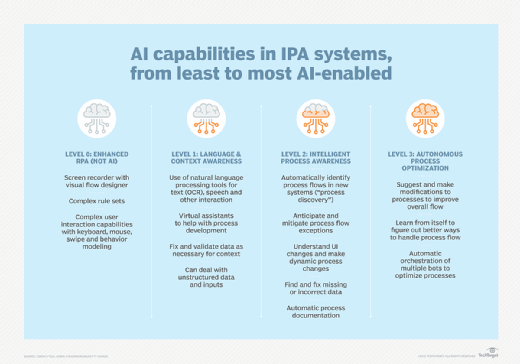
Three different types of RPA
Robotic process automation tools offer two distinct modes of deployment: assisted automation and unassisted automation, also referred to as attended and unattended RPA. Hybrid RPA combines the two models.
RPA experts David Brain, chief digital officer and president at Sykes Digital Services, and analyst Phil Fersht, co-founder and CEO of HFS Research Ltd., explained in their foundational article on creating RPA architecture that each RPA model has its benefits and limitations. It's important that companies determine which model best meets the organization's needs before deploying RPA.
Assisted (aka attended) automation. In assisted automation, the RPA is automating applications running on a user's desktop typically for the purpose of helping the user complete an involved process in less time. This usually generates cost savings and helps deliver a better user and customer experience. Drawbacks to assisted automation, explained Fersht and Brain, is that inconsistencies on the desktop setting, such as changing graphics or display settings, can cause the RPA to fail. In addition, sometimes the user's desktop is locked when the automated steps are being executed.
Unassisted (aka unattended) automation. Unassisted automation requires no human agent. The RPA software performs on its own, notifying the user only when something goes wrong. Unassisted automation can work 24/7 -- "an ideal scenario for optimizing a process," Fersht and Brain said. But they added that, in order to work, unassisted automation requires structured data and clearly defined rules, which may not exist in every case.
Hybrid RPA. In hybrid RPA, the employee and bot essentially work as a team, passing tasks back and forth. Hybrid RPA automates the work that can be completed solely by the bot (unassisted) as well as work that that involves unstructured data or requires decisions by an employee (assisted). In hybrid RPA, the software bots and employee can work on different tasks at the same time for optimal efficiency. The Institute for Robotic Process Automation and Artificial Intelligence, an association for automation professionals, touts hybrid RPA as helping "companies leverage the power of automation in a more diverse range of processes and scenarios." Learn more about the three types of RPA here.
Evolution of RPA and RPA 2.0
The term RPA entered the tech lexicon in 2012, but its roots go back to mainframe-era screen scraping. With screen scraping, a software tool would take legacy application data formatted to appear on an IBM 3270 -- or a similar old-style terminal -- and reformat the data for use on a client-server or web-based system. This approach provided an inexpensive and noninvasive way to link systems.
Present-day RPA also provides an unobtrusive approach to integrating systems by emulating the steps humans take when interacting with an application's user interface. It remains a relatively inexpensive way to connect disparate systems where APIs don't exist and there is not the time or budget for recoding applications or heavy-duty systems integration. But RPA has evolved well beyond screen scraping. It can handle more complex processes, adjust to changes in the underlying systems and scale beyond localized deployments.
Large law firm pairs RPA and AI to transform customer service.
RPA 2.0
RPA 2.0 refers to the fact that RPA platforms continue to evolve, pairing up with technologies such as process mining to identify the right automation candidates for RPA and incorporating machine learning, which enables platforms to automate longer and more complex tasks, including whole job roles.
"The fact that RPA has advanced so quickly beyond task automation as to replicate whole job functions is fascinating, from both a positive and negative perspective," noted Pankaj Chowdhry, founder and CEO of the AI and RPA startup FortressIQ, in a report on the evolution of the robot workforce.
Read more on the evolution of RPA in this in-depth look at RPA's transition from screen scraping to AI-assisted process automation.
COVID-19 and 'hyperautomation'
The workplace disruption caused by the COVID-19 pandemic accelerated digital transformation efforts at many companies. The massive shift to remote work not only underscored the need for digitizing manual processes, but it also shone a spotlight on the benefits of coordinating automation across the enterprise.
Hyperautomation, a term coined by Gartner, refers to the framework and set of advanced technologies required for making enterprise automation scalable and strategic. The concept reflects the insight that RPA can be challenging to scale and is limited in the types of automation it can achieve.
The ultimate goal of hyperautomation is to automate process automation in the enterprise. As explained in our in-depth definition of hyperautomation, advanced technologies used to achieve scaled automation include the following: process mining tools, RPA, no-code/low-code development tools, iPaaS, and AI tools, including machine learning and natural language processing.
A new forecast from Gartner predicted that the worldwide market for technology enabling hyperautomation will reach $596.6 billion in 2022, up from $481.6 billion in 2020 and a projected $532.4 billion in 2021.
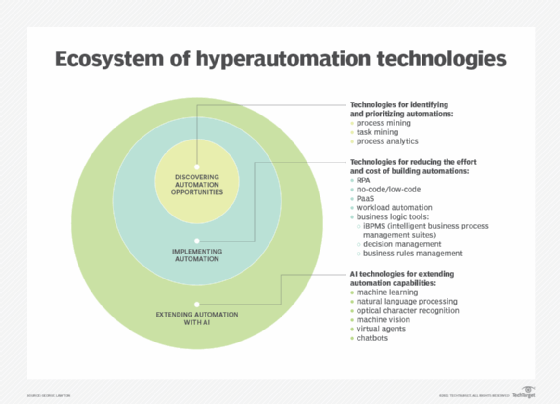
What business processes are automated by RPA?
Traditional RPA is not appropriate for every business process. Automating a mission-critical, long-running and complex business process is typically a job for IT using API-based automation. (Indeed, Gartner stated in its July 2019 Magic Quadrant on RPA that the word task would be more accurate than process in the RPA acronym.) Here are some characteristics that make a process suitable for traditional RPA:
- It is high volume and repetitive.
- It relies on structured digital data.
- It has clear business rules and low or no exception rates.
- It is prone to error when using human labor.
- It is time-sensitive or highly seasonal.
Business processes and their associated applications should be stable before applying RPA. For companies embarking on RPA, Forrester Research analyst and RPA expert Craig Le Clair has recommended they heed the "rule of five" when determining which processes are suitable for RPA:
- Five decisions: RPA works well for simple applications that operate in high volume. Applications involving more than five decisions will require a BPM rules engine, Le Clair said.
- Five apps: Because RPA doesn't rely on APIs, bots are sensitive to changes in applications. "When applications change, they often break the bot" and cause companies to give up on RPA, Le Clair said. Limiting the number of applications involved to five or less will help companies keep on top of changes.
- 500 clicks: Keep the number of keystrokes a bot has to master to 500 or less.
What is RPA used for?
RPA is used by business functions across the enterprise. Top RPA use cases include the following:
Customer service. RPA can improve customer service by automating contact center tasks, including verifying e-signatures, uploading scanned documents and verifying information for automatic approvals or rejections. In addition to standardizing and speeding up rote tasks, RPA frees up agents to focus on solving customer problems and strengthening brand relationships.
Finance and accounting. Finance and accounting processes that lend themselves to RPA include procure to pay, accounts receivable, general accounting, tax accounting and compliance, financial planning and reporting. Read this article on the benefits of using RPA in finance for more examples.
Human resources. HR tasks being automated by RPA include payroll, time and attendance management, onboarding and offboarding, compliance and recruiting new hires.
IT management and services. Examples of how RPA can be applied to IT include automating software audits, managing source-code control, handling incident resolutions such as password resets and server restarts, and optimizing email notifications.
Supply chain management. RPA can be used for procurement, automating order processing and payments, monitoring inventory levels and tracking shipments.
What are the benefits of RPA?
Hard data on the benefits and drawbacks of RPA by industry not only varies from study to study but also is often contradictory. In a fast-moving market where the research is colored by vendor interest, the absence of agreed-upon statistics is perhaps not surprising.
The following benefits are widely cited by companies that have deployed RPA:
- Accuracy. Set up correctly, bots complete the process the same way every time and don't get fatigued, reducing error rates and inconsistency.
- Compliance. RPA tracks bot performance and stores the data for auditing compliance with regulatory and governance requirements. It also reduces human interaction with sensitive data, reducing the potential for fraud.
- Cost savings. Job loss due to automation is a sensitive topic, and companies are circumspect about using RPA to eliminate jobs, preferring instead to tout the revenue and business benefits generated by a 24/7 bot operation with no downtime. Companies that hire seasonal workers for data transcription work, such as retailers during the holidays and accounting firms during tax time, have reported that RPA has allowed them to handle peak times with far fewer seasonal hires.
- Employee productivity and morale. Automation of repetitive, mind-numbing tasks allows employees to be more productive and frees them up for higher-value work.
- Digital transformation. Using RPA, companies can automate parts of processes without making changes to legacy systems or investing in costly and time-consuming back-end integration with existing systems, allowing them to move forward on digital transformation.
For firsthand accounts of the benefit RPA is providing companies, check out this panel discussion with executives at TTI, Suncor Energy and Keppel Corp. on how to succeed with RPA. One tip: It's important to get a few quick, easy wins.
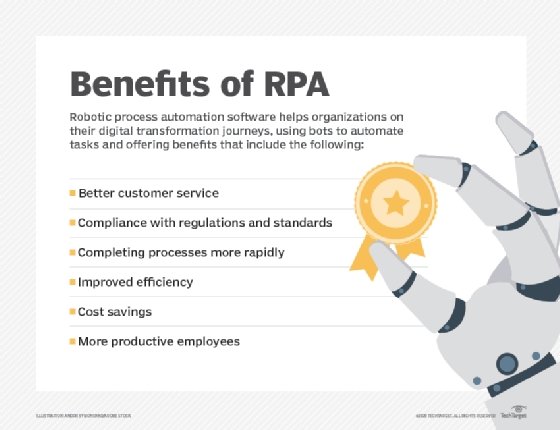
What are the risks of RPA? Why do RPA projects fail?
EY, a provider of RPA services, reported that as many as 30% to 50% of initial RPA projects fail.
One common mistake companies make, according to the study, is assuming that RPA is an IT project. Because RPA mimics how humans complete the various tasks associated with a business process, it is important that RPA implementations be driven by the subject matter experts and employees who understand the steps of the as-is process and have informed opinions about how it could be improved with automation.
Underestimating human capital, implementation failure
That said, it is critical IT be involved in full-scale RPA deployments. Companies often underestimate the IT expertise and infrastructure required to maintain and fine-tune the RPA bots. While it's the case that most business users can automate a simple process themselves using the drag and drop menus RPA vendors typically provide, launching and maintaining a full-scale enterprise RPA implementation requires administrative and IT oversight.
Indeed, the ease of getting RPA up and running -- one of the automaton tool's big selling points -- is also a major risk and can result in bots run amuck. Simply automating the work flows of employees who are not doing the task correctly, or each doing it in a different way, is bad practice, explained Bob De Caux, vice president of AI and RPA at enterprise software provider IFS, in his primer on the benefits and downsides of RPA. Without a strong governance plan for RPA bots, companies can end up with a hodgepodge of redundant bots instead of the end-to-end process automation that brings measurable economic impact.
Security risks
RPA also introduces security risks, but not the ones you might expect. Saurabh Gupta, president of research and business operations with HFS Research Ltd., and Martin Sokalski, principal in KPMG's Emerging Technology Risk division, explained in an in-depth interview on security risks and remedies that big data breaches have not thus far been seen in RPA implementations. They said that's in large part because the technology works as a top layer and is not integrated into the under layers where the data is. However, RPA security risks do exist: They include fraud, inappropriate access to sensitive data, being able to affect system availability and continuity, and abuse of administration privileges. "Data privacy can be in that bucket as well," Sokalski said.
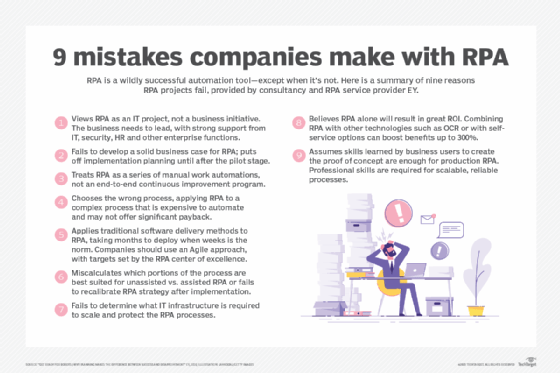
What companies and industries use RPA?
Industries that are computer-dependent and have large volumes of rules-based processes currently handled by full-time employees stand the most to gain from RPA. The finance sector led the way in RPA adoption, followed quickly by insurance, government, manufacturing, retail and utilities. Click on the hyperlinks below to get the details on how companies are using RPA.
Banks and insurance providers were among the first to see the value in using RPA for automating data transcription tasks. Read about how executives at John Hancock and Citizens Group are using RPA to automate business processes.
Government: Federal agencies are under mandate to modernize their operations, including automating the manual processing of data and documents. The Trump administration's 2020 budget called on agencies to upgrade the consumer experience with RPA.
Healthcare: Use cases for RPA in healthcare range from handling patient records and claims to customer support, account management, billing, reporting and analytics. A.J. Hanna, former head of Ascension Health Alliance's digitization strategy and now a vice president of client advocacy at Sykes, laid out the potential benefits of RPA in healthcare.
Manufacturing: Shibaji Das, senior director value engineering for UiPath, discussed the role of RPA in manufacturing and how it can help improve efficiency in organizations.
Retail: Read about how U.K. retail group John Lewis Partnership has automated 40 business processes using 60 software robots with technology from Blue Prism.
Utilities (electricity oil, gas, etc.) use RPA for accounts and billing, meter-reading exceptions, customer service queries and debt recovery. Read about Schneider Electric's ambitious, multivendor rollout of RPA in its customer care, finance, HR and supply chain divisions.
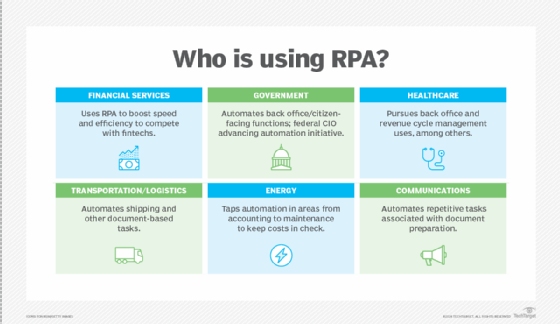
RPA software: Who are the vendors? What is the cost?
Below is a brief description of the three leading enterprise RPA vendors -- Automation Anywhere, Blue Prism and UiPath -- along with a select group of up-and-coming and niche players. For more information on RPA vendors, including pricing and licensing information, click on "Consider these 12 RPA software vendors for deployment."
- Automation Anywhere provides a "wide array of integration components that users can string together to create automation scripts," according to Gartner, as well as a well-developed partner ecosystem. Updates include a mobile phone app for managing bots and more ability to automate unstructured data; Gartner noted that its 2020 roadmap includes an improved bot store, conversational AI and an RPA-as-service option. Forrester Research called out its focus on "human-bot collaboration."
- Blue Prism focuses on providing organizations in regulated industries, in particular financial services, desktop-aligned robots that are defined and managed centrally. The publicly traded company maintains its focus on IT-led enterprise deployments and has a strong innovation roadmap, according to Forrester Research. This includes its Blue Prisms Lab, an AI lab "targeting document-centric use cases, computer vision and attended [aka assisted RPA] scenarios."
- UiPath offers a "well-structured partner ecosystem … that enables it to support integrations with major products and applications covering BPM, process mining and AI," according to Gartner. Its new "AI integration fabric" is touted as adding the cognitive power of AI to software automated by RPA. Developers looking for a Windows-oriented environment "will be comfortable," according to Forrester Research.
- EdgeVerve Systems, a wholly owned subsidiary of business process outsourcing (BPO) vendor Infosys Limited, is an example of how the BPO industry -- thought to be a casualty of RPA -- has become a major user of the technology. Forrester Research noted that EdgeVerve "blends services expertise with platform features." The product includes frameworks for an automation center of excellence, governance and process discovery as part of an overarching vision for converging AI and automation, the consultancy said.
- HelpSystems enables companies to streamline IT and business operations by automating tasks and workflows without the need to write code.
- Kofax is strong at "document-heavy process automation and orchestration," according to Forrester Research. Gartner stated that the vendor excels in delivering end-to-end automation.
- Microsoft "has caught up with" RPA leaders, according to Forrester Research. The mega vendor moved closer to its vision to "deliver the most comprehensive SaaS intelligent automation product," the firm noted, with its acquisition in May 2020 of RPA provider Softomotive.
- NICE established an RPA line of business in 2016. The product focuses on enterprise-grade implementations, providing both attended and unattended RPA workloads; Customers are attracted to the vendor's expertise in using RPA to automate contact centers, driven by a focus on voice and text analytics. Specialized attended bots "augment [NICE's] workforce management functionality across a range of vertical industries, including finance, banking, telecom and manufacturing," Gartner said.
- WorkFusion combines robotics, AI-powered cognitive automation and workforce orchestration to automate enterprise business processes. Its product's focus on governance of RPA bots makes it a "strong choice" for banks and insurance companies, according to Forrester Research. Gartner has noted WorkFusion's sophisticated ML capability.
Vendor capabilities in the fast-evolving RPA market keep expanding, as do the number and types of companies claiming to offer RPA tools. According to a July 2020 report from Gartner, RPA software tools "at minimum" should include the following capabilities: "low-code capabilities to build automation scripts, integration with enterprise applications, and orchestration and administration, including configuration, monitoring and security."
C-level decision-making around RPA
As companies continue to increase their use of RPA, lack of leadership and IT expertise threaten to undermine the benefits of RPA and magnify its drawbacks, according to IT research firm Everest Group (see chart "5 RPA pain points C-level leadership needs to address").
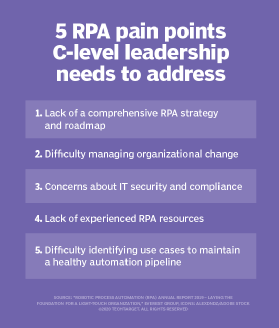
To capitalize on RPA, strong C-level leadership is required to ensure that business outcomes are achieved, new governance policies are met, and the people whose jobs have changed due to RPA are trained to take on new responsibilities (see section "What are the risks of RPA? Why do RPA projects fail?").
To take RPA use cases to the next level, experts recommend companies establish an automation center of excellence, or control center. "From this center, administrators are provided with the operational agility to properly launch, maintain and upgrade their RPA systems," explained Fersht and Brain. An enterprise center of excellence (CoE) team often includes C-level "champions," change management experts, solution architects, business analysts, software developers, engineers and support staff.
But CoEs can also "crumble under their own weight," warned Gina Schaefer, managing director and intelligent automation leader at Deloitte Consulting LLP. A detailed look at how C-level execs can direct and support RPA projects is laid out in this expert tip on RPA guidance for C-level decision makers.
What to look for in RPA software
Enterprise leaders should consider a number of features when vetting RPA software, including the following:
- Scalability. Organizations should look for RPA platforms that can be centrally managed and scale massively.
- Speed. Enterprises should be able to design and test new robotic processes in a few hours or less, as well as optimize the bots to work quickly.
- Reliability. As companies launch robots to automate hundreds or even thousands of tasks, they should look for tools with built-in monitoring and analytics that enable them to monitor the health of their systems.
- Simplicity. Organizations should look for products that are simple enough that any employee in the business can build and use them to handle various kinds of work, including collecting data and turning content into information that enables leaders to make the best business decisions.
- Intelligence. The best RPA tools can support simple task-based activities, read and write to any data source, and take advantage of more advanced learning to further improve automation. RPA combined with AI capabilities is still a developing field. Read more about intelligent process automation in this expert tip.
- Enterprise-class. Companies should look for tools that are built from the ground up for enterprise-grade scalability, reliability and manageability.
Where the RPA market is heading
The RPA market continues to be one of the fastest-growing segments in the enterprise software market. It grew 62.9% in 2019, compared with 11.5% growth for the overall enterprise software market, according to Gartner's 2020 Magic Quadrant on RPA.
Automation Anywhere, Blue Prism and UiPath continue to dominate the field. But, as Gartner and others have noted, the market is evolving quickly. Mega-vendors, including Microsoft, SAP, IBM and Google, have entered the RPA market, along with vendors from "adjacent product sectors" such as intelligent BPM suites and low-code application platforms. In addition, more BPO vendors are offering RPA.
"There is still a great deal of fragmentation of vendor offerings and interest from vendors in adjacent markets (software and cloud)," Gartner observed, adding that it expects the market to consolidate and mature over the next three years.
Meantime, RPA spending shows no signs of cooling. As enterprises accelerated their digital transformation efforts during the COVID-19 pandemic, RPA played a key role in automating paper-based, routine processes.
Concerns that RPA will hit a wall once enterprises have automated routine tasks and move on to automating complex processes have been mitigated by advances in RPA. Leading RPA vendors are extending the capabilities of their tools. New capabilities aim to better support management, scalability and integration with other tools, including AI, digital process automation, process mining and business rules engines.
As noted in the guide's section on hyperautomation, enterprises are seeing the value of a developing a comprehensive strategy for process automation that combines automation tools -- including RPA, digital process automation, low-code/no-code platforms and business rules engines, among others -- with machine learning and other AI technologies.
Enterprises should look for RPA providers that enable "scaling and scope extensions," Forrester advised in its March 2021 Forrester Wave review of 14 RPA providers. Some examples of RPA augmentations cited by Forrester include "AI-decisioning tools that automate processes in the banking and insurance industry" and "digital assistants that offer an additional channel to the RPA platform."








